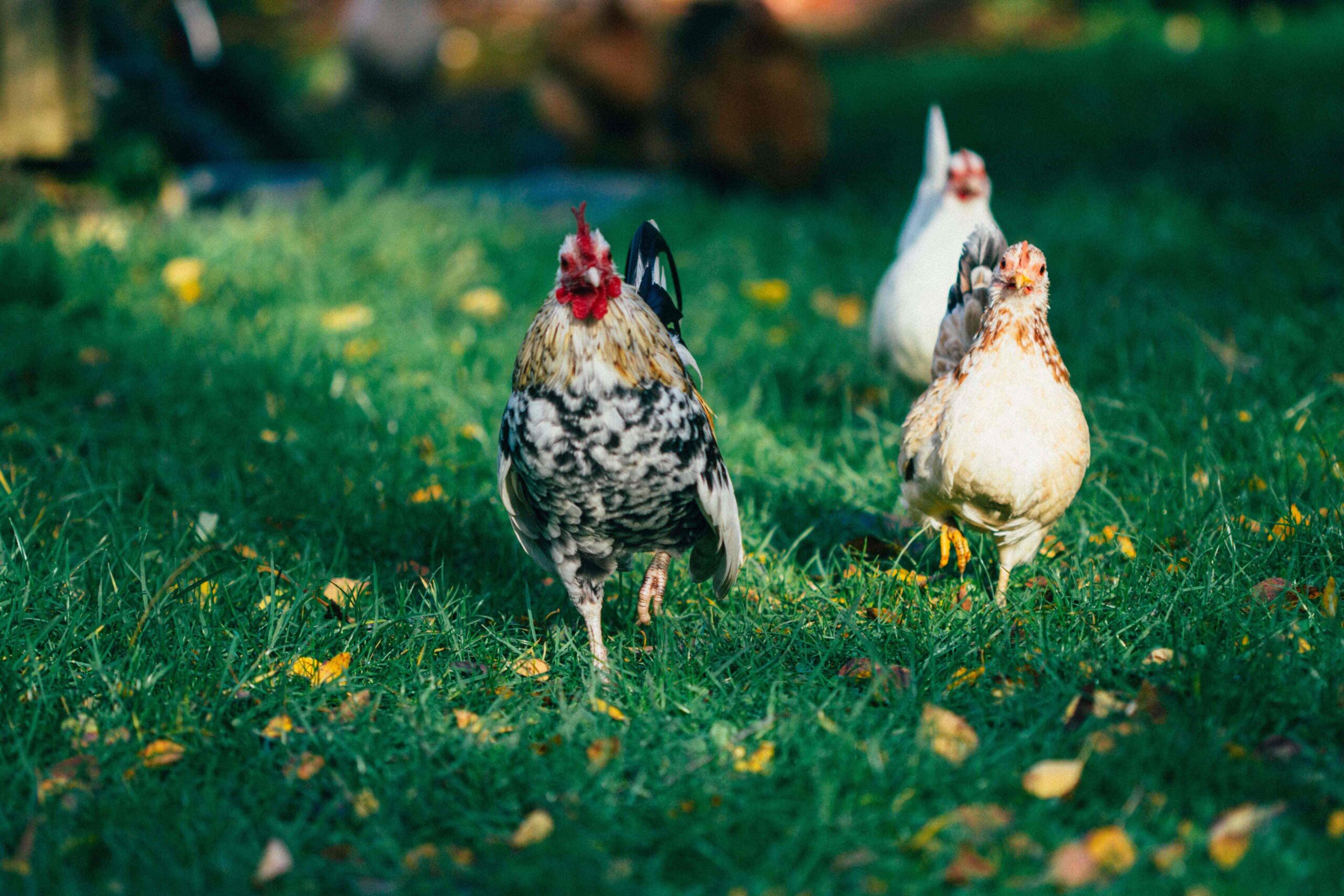
Chickens are colour blind
FALSE – Chickens actually have superior colour vision to humans. Thanks to five light receptors in the eye (humans only have three), they can see many colours more vividly than us.
Chickens can be half male, half female – split down the middle
TRUE – Due to a phenomena called bilateral gynandromorph there are chickens where one side of the body is male (large wattle, spur and muscular breast etc.) and the other side is female (duller plumage, smaller comb, slighter build etc). Worth a google!
There are as many chickens as there are humans on earth
FALSE – There are almost 4 times as many chickens as there are humans, more than 25 billion. In fact, there are more chickens in the world than any other bird.
Chickens navigate through magnetic fields
TRUE – Like other birds, chickens use the magnetic fields of the earth to orientate themselves and navigate around their home environment. Additionally, studies show that chickens use the sun to tell the time of day. Daylight intensity is also what tells cockerels when to crow in the morning and when to go roost at night.
Chickens are cannibals
UNDECIDED – You might have heard about cannibalism in poultry, and it does happen that chickens start pecking the flesh of other hens. This is however not a natural behaviour seen in the wild, but a result of a stressful environment with limited space in large egg or meat factories. A happy chicken will not eat its friend.
Chickens have no taste buds

FALSE – While it may seem like chickens will eat just about anything you put in front of them, they do have taste buds, and personal preferences. A chicken can’t taste sweetness or spiciness, but can tell saltiness, sourness and bitterness apart.
The colour of the egg affects the nutritional content
FALSE – Despite what some egg producers have claimed during the years, brown eggs are not healthier than white ones, or vice versa. The colour of the shell only depends on the breed of chicken it came from, and will have no impact on taste or nutritional content.
If you chop their heads off, chickens will keep running
TRUE – Some chickens will indeed keep running after having their head chopped off. The pressure from the axe triggers nerve endings in the neck, sending a message back to the muscles telling them to move, without the brain actually being involved.
The chicken is then moving while actually being dead, but in the case of Miracle Mike, the farmer who tried to kill him aimed a bit high and accidentally left a bit of the brain that chickens keep at the back of their necks. This made it possible for Mike to live for another 18 months (!) after his head had been removed.
You can hypnotise a chicken
TRUE – There are several ways of putting a chicken in a trance, but the most common one involves holding the chicken with its head close to the ground, and drawing a line in the ground going outwards from the beak. This will paralyse the chicken, and she will stay laying still until you clap or poke her.
While it probably won’t hurt your chicken to hypnotise it like this, it’s unclear how much stress it causes her, so make sure not to do it too frequently.
This entry was posted in Chickens on August 31st, 2020 by linnearask

Most cats don’t need much persuading to use a litter tray. This makes training a straightforward process, and the key detail is the tray itself.
A litter tray needs to be large enough to accommodate your cat comfortably while it’s using the facilities. It also needs to be placed in a suitable spot. Cats feel vulnerable when they’re relieving themselves, and will not use a litter tray in a busy part of the house. A quiet corner is what they need – but it should be away from the feeding area, as cats, like humans, do not like their eating and toileting activities to be in the same space!
The cat litter itself is not usually an issue. All the available brands do the job. The advantage that shop-bought products have over plain sandy soil is that they are super-absorbent, and don’t stick to the cat’s feet. It is best to avoid perfumed or deodorizing litter, unless the additives are all natural. Chemical perfumes can cause allergic reactions in some cats.
Basic Litter Training
A young kitten with a weak bladder – or a stressed rescue cat – may take time to get the hang of litter trays, but it is rare for a cat to fail this basic training course!
- Make sure the tray is big enough. If in doubt, get the biggest one you can. This will accommodate the growing cat, and the tray will not seem ‘full’ after a couple of visits. If the cat thinks the litter is too soiled, it will not want to enter the tray.
- If your cat is particularly shy, a covered tray is the best option, as these give more sense of privacy.
- If you have more than one cat, it is recommended that you should have one tray per cat. This prevents problems if the pets fall out or decide they’re not going to poo where another cat has just pooed!
- Remove the solid waste from the tray each day, and thoroughly wash it – and replace the litter completely – at least once a week. If the tray starts to smell too unpleasant, the cat will be tempted to relieve itself elsewhere else.
- In the early days, timing is important. A kitten will usually need to relieve itself after playing and after eating. When a young kitten has finished eating, carry it to the litter tray. A few sniffs and a bit of litter-pawing will often stimulate the desired response. You can also play with your kitten next to the litter box, ready to lift her onto the tray when play has ended.
- Lead by example. Not by actually using the tray yourself, of course, but by pawing the litter with your finger. Don’t take the cat’s paw and force it to dig, though, as this can be stressful and may even lead to litter phobia, which is definitely not what you want.
- If accidents happen outside the litter tray, put the droppings in the tray as a prompt for the cat.
- Be patient, never shout at the cat if it’s taking a little time to get the hang of it, lavish praise and affection on a successful litter-visit, and once your pet knows what to do, just quietly leave her to it.
Litter Training Problems
If the cat is resistant to the idea of using the tray and continues to use other parts of the house as the toilet, one effective deterrent is to move the cat food bowl to the place where the accident happened. Cats do not like mixing and matching their food and toilet, so this should help her move on to the more appropriate facilities.
If the message is still not getting through, confining the cat to a spare room may do the trick. With the litter tray at one end and the food and water bowl at the other, it would be a very perverse cat indeed who did not get the message. It may sound a little like a prison, but as long as the room isn’t too hot or cold, the cat will feel secure. You can visit for playtimes too, of course, and the need for confinement will usually be over in a couple of days.
Cats that persistently refuse to use a litter tray may be stressed by something in their environment. This could be other cats, a dog, noisy children, or the simple fact that the tray is not in a suitable location. There are occasionally health-related issues that make a cat ‘miss’ the tray, too, so that’s worth checking out if you’re not making progress with the training.
Otherwise, litter training a cat is simplicity itself.
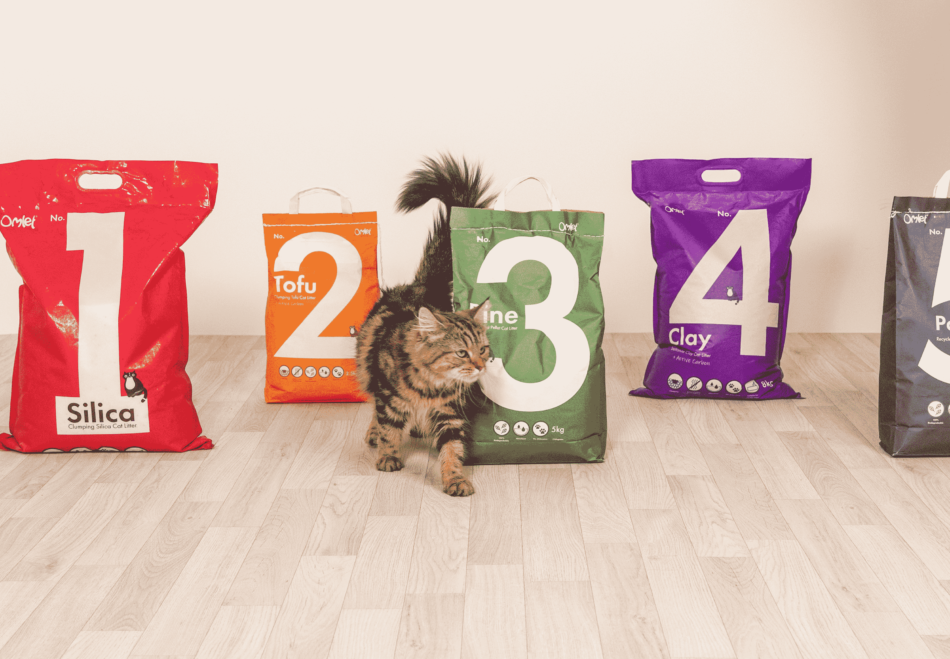
This entry was posted in Cats on August 24th, 2020 by linnearask

What is FIV?
FIV, or Feline Immunodeficiency Virus, is a viral infection that affects cats all over the world. It’s not in itself particularly dangerous, but steadily weakens the cat’s immune system, making them more susceptible to secondary infections.
FIV can be found in 2.5-5% of all cats worldwide, but is less common in healthy, domesticated cats like our pets.
How can my cat catch it?
FIV is spread through direct contact with an infected cat, most commonly through bites and wounds, which is why unneutered male cats prone to fighting for territory are over-represented among cases. Some evidence shows that mums can pass the infection onto their kittens, but it is rare. Infection through social grooming, sharing food and water bowls, and general close contact is very rare.
FIV can’t be transmitted between species, so infected cats can live with humans and other pets, but should be kept in a single cat household to be on the safe side.
How does it affect my cat and how do I spot it?
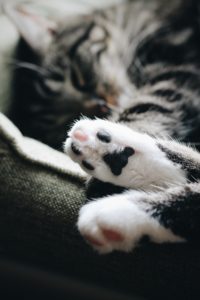
FIV starts with a short, normally relatively manageable illness that is not always noticed by the owner. After this the cats’ immune system will start to slowly deteriorate, but it can be years before it actually affects your cat in any way.
Something that will make a vet react and test for the infection is a cat that seems to struggle to recover from minor infections and illnesses. The cat doesn’t necessarily need to be very ill, it’s more a question of how often he or she needs to see the vet, or if they seem to be constantly battling some kind of health issue.
FIV positive cats are more susceptible to certain types of tumours, serious respiratory infections, skin diseases and mouth inflammations. That being said, research shows that infected cats have a similar life expectancy to healthy cats, and will in most cases be able to live a long and happy life if kept inside and looked after by a caring owner.
Can FIV be cured?
The simple answer is no, there is no cure for FIV, but as it’s secondary diseases and infections that mainly affect the cat, there are in most cases treatments, and there is no reason that a FIV positive cat won’t make a great pet for years to come.
A vaccine against FIV has been developed, but its efficiency has been questioned, and it’s currently only being used in some places in America.
What can I do if my cat is infected?
As FIV is spread through direct contact with other cats, it’s very important that infected cats are kept indoors. Not only does this stop the cat from passing on the disease to other felines, but also reduces the risks of catching secondary infections that due to their weakened immune system can make them very ill.
If you have a cat with confirmed FIV that can’t be let outside, they will still greatly benefit from some fresh air. The Omlet Outdoor Cat Run makes it possible for your cat to be outside and interact with the world around them, without the risk of running into any other cats. Decorate the run with some toys and a climbing post and let your cat play while you potter around the garden, or put a chair inside and take the opportunity to spend some quality time with your pet in the sunshine.
Other things you can do to help your cat is to take him or her for regular check ups, and to contact your vet as soon as you notice any changes, even if minor, in your cat’s health or behaviour. Also make sure to give a nutritious and well-balanced diet. Raw food diets are not recommended for FIV positive cats as uncooked meat and eggs can be dangerous to cats with a compromised immune system.
This entry was posted in Cats on August 24th, 2020 by linnearask
Hens are always talking amongst themselves. All those clucks and squawks mean something, and while some of the meanings of these chicken sounds are obvious – the explosive squawking of a bird running away in panic, for example – others are more subtle.
Here are ten ways in which you can eavesdrop on the chicken chat and brush up on the bantam banter.

Chicken sounds and what they mean
A calm, gently rising borrrrb
This is the chicken sound hens make as they peck their way through the grass or chicken run, and it means two things. It indicates that the chicken is enjoying the endless search for quick snacks, and it’s also telling the other birds ‘everything is fine’. A flock of hens saying borrrb together sends out the reassuring message that there’s nothing to worry about.
The cluck-cum-squawk
This brief, excited cry usually means that there has been some sort of confrontation, usually between a meek hen and a more dominant one who has muscled in to see what snacks the more timid bird has found. The sound is also used if a hen is surprised by something, such as the chicken-run door opening suddenly.
The ‘squawk bomb’
This is when the hen clucks, gobbles and squawks in one hysterical flurry. It sounds as if the bird is about to explode in a cloud of feathers. This is the chicken’s main alarm call, expressing fear and also telling the other birds to run. The causes can be vehicles, dogs, people trying to pick up the hen, or predators.
Cackling
This is the name often used for the familiar Buk-buk-buk-badaaak! call. Repeated several times, and loudly, it is the sound many hens produce after laying an egg. The hen moves away from the egg and then begins cackling. It is thought to be a way of luring potential predators away from the egg and the nest.
Buk-buk-buk (but with no badaaak!)
This slightly angry and persistent sound is often made by a hen who wants to sit in her favourite nest box but finds it occupied. It’s meaning is a combination of “I’m here!” and “Get out!”
Growling
If a hen is broody and doesn’t want to move from her nest box, she will make a hissing, growling sound. This simply means “Don’t touch!” and “Go away!”
Chick-chat
A hen hatching eggs will mutter various gentle clucking sounds to communicate with the chicks and reassure them. Once the chicks are hatched and running around, she tells them where the good scratching and pecking places are by saying tuk-tuk! (Cockerels use this sound too, to tell the hens that they have found a good foraging spot). Mother hens also have an insistent Rrrrrr call, which is the chicks’ cue to come running if the hen senses danger.
Crowing
This is cockerel territory, the classic cock-a-doodle-doo – although some hens get the crowing habit too. Crowing says several things. It means a new day has dawned, and it’s time to be up and scratching/pecking. It also tells the world that this is the cockerel’s territory, and that these hens are his. If there is more than one cockerel, the subordinate ones will only crow when the boss has crowed. Crowing usually hits 90 decibels, or even more!
Help!
A hen separated from the flock will make an alarm call. The sound is similar to the ‘cackling’ that announces a new egg. It is thought to be an SOS call to the cockerel to come and save his lost hen. There will be a strong element of danger if there are predators around, so it’s a risky strategy for a lost chicken.
Buzzing
First thing in the morning, with the chicken coop still locked, the hens will begin to make repetitive, buzzing clucks, which may rise in volume as the minutes pass and the doors remain shut. This sound simply means “Let us out – there’s lots of pecking and scratching to be done!”
With this knowledge of chicken chit-chat, you will be able to tell what your girls are talking about, even if you can’t actually see them. It’s an all-day, non-stop conversation!
Want to find out more about the wonderful world of chicken keeping? Take a look at the Omlet Chicken Guide for tips, tricks and advice! You can also visit the Omlet website to find everything you need for your flock including Chicken Coops, Walk in Chicken Runs, Chicken Fencing and more!
This entry was posted in Chickens on August 21st, 2020 by linnearask


Photo by Matthew Foulds on Unsplash
1. We talk too much
Dogs don’t know English, and they won’t understand syntax and grammar however much you try to teach them. As you can imagine, it will be extremely frustrating having a human shouting incomprehensible noises at you.
Dogs like learning spoken commands and connecting them to actions, but won’t be able to understand anything longer than a short sentence, and will be very confused when you start using new ways of telling them to do things. If you’ve taught them the command “Drop” to get them to give you a stick or a toy, then “Leave” or “Let go” or “Give me that, you silly sausage!” won’t be of much use.
2. We let other people into our territory
Humans think it’s normal to go to other people’s houses, and to let individuals from outside the pack come into your and your dog’s territory. This will annoy some dogs immensely, and can actually make them really stressed, so don’t be surprised if they treat visitors with suspicion.
If you want to invite other dogs into your house, it might be a good idea to let the dogs meet on a walk beforehand, on neutral grounds. Most dogs will be absolutely fine with sharing their space, but it’s always best to minimise the risk of arguments.
3. We stare at them
We think that eye contact is something beautiful that is needed for bonding, and with both our own dogs and new ones we meet we tend to look into their eyes as we’re saying hello. Most dogs don’t appreciate this. While loving gazes between you and your pup is often accepted, being stared down by a stranger can be extremely stressful for a dog. They see the focused stare as a challenge, and might consider you a threat, so try to avoid eye contact with dogs you don’t know.
4. We hug them
This is a slightly contentious topic, but many people mean that while dogs accept our hugs, they don’t like them. It depends on the dog, but some feel very nervous and stressed when we interfere with their personal space, and placing your arms around a strange dog’s neck can be seen as a threat.
Most dogs like snuggling, and nearly all love scratching, so if you want to be sure you can show your affection with a belly rub and shared sofa rather than constraining your pup with your weird human arms.
5. We don’t let them sniff on walks
For dogs, walks are not just about exercise. While we humans can stop to enjoy beautiful scenery, dogs explore the world much less visually, and prefer to snuffle around for interesting smells. This also provides them with great mental stimulation that will tire them out just as much as the actual walking, so try to be patient with your dog and let him or her stop, sniff and mark as much as they like on a walk.
6. We change our shape and smell
Dogs change their coat roughly once a year, whereas humans change clothes every day, use different hand soaps, spray themselves with perfume and use cleaning products in their homes. Dogs might get to grips with this unusual behaviour after a while, but they will definitely not see the point, as they would probably prefer it if we never washed and walked around in the same clothes all the time.
7. We’re inconsistent
Dogs get very confused with inconsistency. They don’t understand “just this once” or “only when mummy is on a work trip”, but will much prefer to for example always be off the bed rather than having to constantly try to interpret your varying signals.
8. We leave them alone
To dogs, some of the strongest pack animals around, leaving the group seems absolutely pointless and stupid. That’s why they can get confused and annoyed when we leave them alone to go to work or to the cinema.
Train your dog to be by themselves from an early age to avoid bad separation anxiety, and try to never leave an adult dog alone for longer than four hours a day.
9. We get frustrated when they’re being dogs
To dogs, sniffing, barking, digging and scavenging for scraps are all natural behaviours, and they can get very annoyed if you get upset with them for doing what comes natural to them. This doesn’t mean that they should be allowed to do exactly what they want all the time. Try to redirect and encourage desirable behaviour, but it’s also worth remembering that dogs are dogs, and that’s part of why we love them so much.
This entry was posted in Dogs on August 19th, 2020 by linnearask
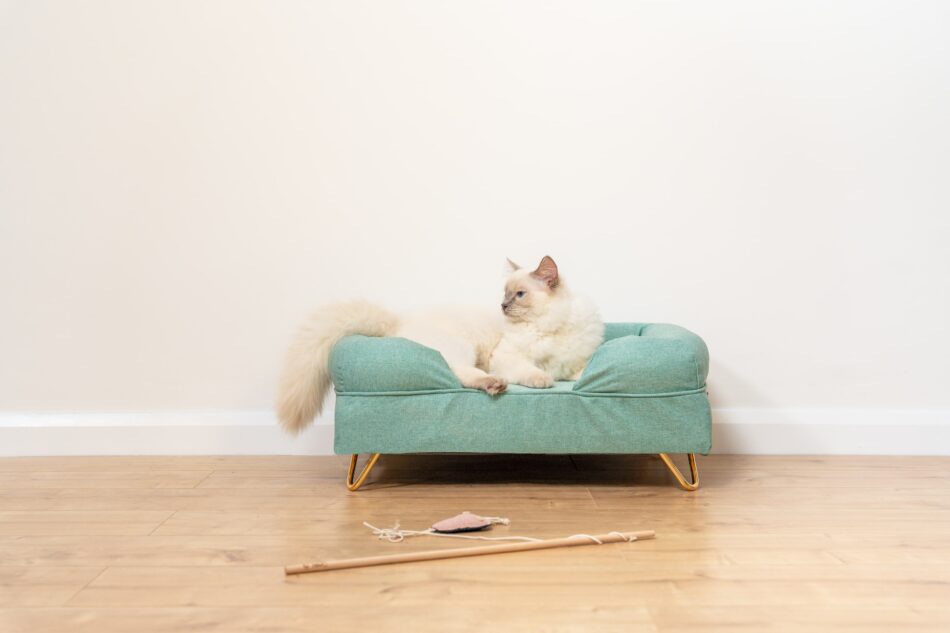
Allergy to cats is the most commonly seen of all pet allergies, almost twice as common as the dog equivalent. It’s estimated that up to 3 out of 10 people have some level of reaction to felines, but to what extent it limits peoples’ ability to spend time with cats varies greatly.
Common symptoms of cat allergy include one or several of the following symptoms after having been around a cat, or having spent time in a house where cats live:
- Coughing and wheezing
- Itchy and blotchy rash on the chest and face
- Red and itchy eyes
- Sneezing
More extreme allergic reactions are shortness of breath, severe swelling, and in bad cases anaphylactic shock. If the allergy is present but not as prominent people might at first be absolutely fine around cats, but over time experience never ending fatigue and a constant sore throat.
What causes these symptoms?
Opposite to many people’s belief, it’s not actually hair that causes pet allergies, but a protein produced in oil glands on the skin, and is found in cat saliva, urine and dander (dried flakes of skin often found on cat hair). This protein is called Fel d. The World Health Organisation recognises 8 different allergens, Fel d 1-8, and out of these, Fel d 1 accounts for 60-90% of allergic reactions. Its exact biological function is still unknown, but it sure knows how to annoy humans!
People with allergies have an oversensitive immune system that mistakes harmless things, like a cat protein, for dangerous invaders and sends out a strong attack to destroy these invaders. The symptoms allergic people feel are side effects of the body’s defence against the allergen.
What is there to do?
Male cats produce higher levels of Fel d 1 than females and neutered males. The difference is however relatively small, so if you’re struggling it probably won’t matter that much.
The same goes for so-called hypo-allergenic cat breeds. While they do work for some allergic cat lovers, they still produce Fel d 1. So if you have severe reactions to some cats, getting one that produces less dander won’t make it possible for you to live with one. The only thing you can do is to spend time with the breed you’re potentially planning to buy or adopt beforehand and see how you get on.
Antihistamines can be a help to some allergic people; if taken regularly they minimise symptoms and make it possible to spend time in a house where a cat has been. They are normally best taken preventatively, making sure the body is prepared should it come across any triggering allergens. It’s however not recommended to depend on antihistamines on a daily basis to make it possible for you to get a cat. Even if it’s sad, you might have to come to terms with your allergy and that cat ownership might not be possible at the moment.
Finally, it’s worth noting that you can develop cat allergies at any time of your life, even if you’ve never shown any signs before. Allergies are not hereditary as such, but the tendency to develop allergies is sometimes passed down from parents to their children. This means that if you’re allergic to cats, it is more likely that your child will develop an allergy to something. It won’t necessarily be to cats as well, but as it’s one of the more common allergies it’s worth letting your child spend time with other peoples’ cats before getting one yourself.
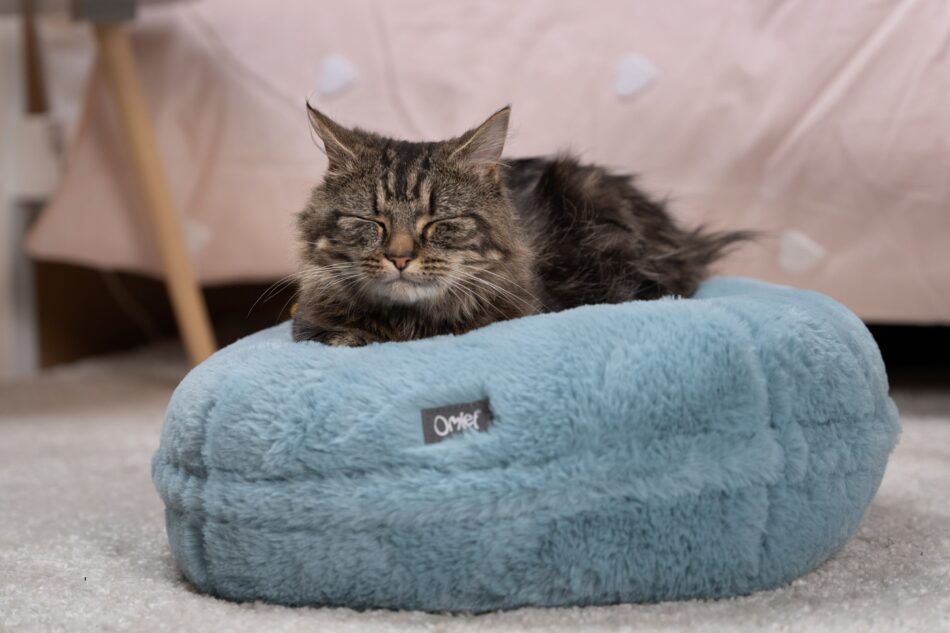
This entry was posted in Cats on August 15th, 2020 by linnearask

Here’s why the Caddi is the perfect choice for your treat-loving pets…
- The Caddi Treat Holder decreases the rate at which your pets will eat their treats. Slower treat release through the gaps in the holder means more satisfaction for longer, and prevents over indulgence.
- The Caddi Treat Holder swings around and creates a rewarding, interactive game to keep your pets entertained, which is especially great for rainy days! Your pets will love the stimulating experience of foraging for their treats, and enjoy hours of rewarding fun.
- The Caddi allows you to feed your pets treats without having to throw them on the ground. This improves run cleanliness, reduces food waste and prevents pests, as well as being a healthier solution for your pets. Simply hang the Caddi from the roof of your pet’s run with the plastic hook and use the string to adjust the height to suit your pets.
- Endless treat opportunities! With the Caddi Treat Holder you can feed a range of fresh greens, fruits and vegetables to your pets, you can use it as a hay rack for rabbits, or fill it with pecker balls for hens. Get creative and reward your pets with exciting new flavours in the Caddi.
- You can save 50% on the Caddi Treat Holder until midnight on Monday, just by signing up to the Omlet newsletter. It’s a great deal for you, and an exciting new treat dispenser for your pets! Enter your email address on the Caddi page to claim your discount code.
Now available for just £4.99 if you sign up to the Omlet newsletter!

Terms and conditions
This promotion is only valid from 12/08/20 – midnight on 17/08/20. Once you have entered your email address on the website you will receive a unique discount code that can be used at checkout. By entering your email you agree to receive the Omlet Newsletter. You can unsubscribe at any point. This offer is available on single Caddi Treat Holders only. The offer does not apply to Twin Packs or bundles with Omlet Peck Toys or Feldy Chicken Pecker Balls. Offer is limited to 2 Caddi Treat Holders per household. Subject to availability. Omlet ltd. reserves the right to withdraw the offer at any point. Offer cannot be used on delivery, existing discounts or in conjunction with any other offer.
This entry was posted in Chickens on August 12th, 2020 by linnearask
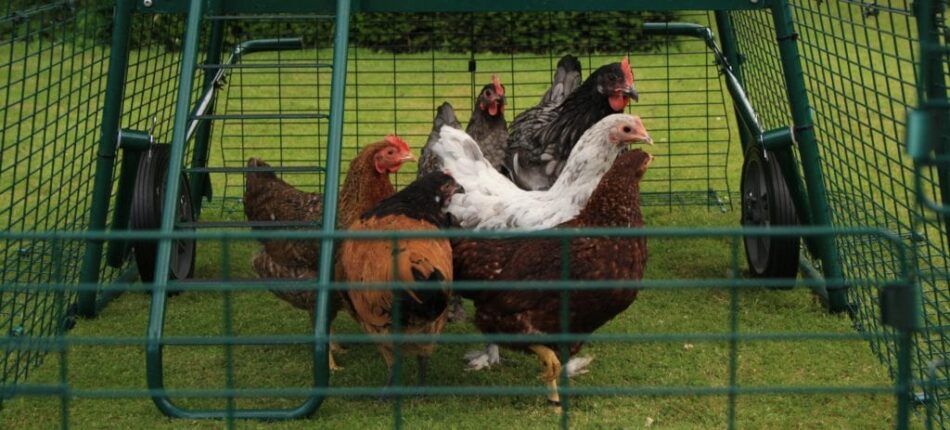
A flock of chickens can easily give the impression of peace and equality, but they don’t start out that way. There’s a “pecking order” among chickens that is established early on and can be challenged and even changed from time to time. Every flock of chickens, whether it consists of two birds or 200, has a pecking order. This natural hierarchy determines the top and bottom-ranking hens. Understanding the pecking order in chickens will help you make decisions about housing, how to set up the run, and look out for potential trouble.
What is a pecking order in chickens?
Adherence to a pecking order is a natural behaviour in chickens and doesn’t usually require human interference. It’s established by the more dominant birds asserting themselves – and the more submissive birds will fall into line. Dominant chickens will usually be first to the feeder and to roost, but will also ensure that the lower ranking members of the flock are taken care of. Much like a monarchy, most high-ranking hens will also see that their subjects are cared for.
Chickens that are raised together from chicks will have already sorted out their pecking order. But, if you’re adding more hens to an existing flock, be prepared to witness the pecking order sort itself out all over again. Each time new members are added to the flock, the pecking order will be challenged.
Interestingly, there is circumstantial evidence that hens’ combs may play a part in the war of the wattles. Hens with large, erect combs tend to be higher in the pecking order than birds with less impressive combs. But, every flock is different, and the pecking order can be challenged and can change at any given time.
Changes in the pecking order
Occasionally, another hen may challenge the top hen for the top place in the pecking order. This is common when new hens are added to a flock, or in established flocks when dominant hens go broody, get older, or become ill. Or, sometimes lower ranking hens will simply test their place among the flock.
Generally, the most aggressive or assertive hens will be at the top of the flock’s pecking order. But, when the situation demands it, dominant hens will have to defend their place at the top. Common behaviour among hens that are working out the pecking order includes:
- Squaring off to each other – sometimes with their feathery hackles raised along their necks
- Small squabbles of pecking or feather-pulling
- A loud commotion of squawking or clucking that lasts a minute or two
Sometimes a chicken seems to rise to the top with very few pecks involved. If a dominant hen is no longer around, the pecking order enters a state of flux, and there may be new outbreaks of feathered fisticuffs before the new order establishes itself.
Occasionally, hens will be overly aggressive or will gang up on a newly added flock member, or one that’s especially timid. Keep an eye out for dangerous behaviour like:
- Excessive pecking, to the point of drawing blood or giving another hen bald patches
- Keeping lower-ranking hens away from food or water
- Pushing lower-ranking hens out of the coop at night
If you notice a hen being bullied, you’ll need to isolate them until they regain their strength. Overly aggressive hens should be kept with other strong-willed hens, and should not be allowed in with a flock of very timid hens. It’s not often that a hen will take advantage of a higher rank, but those that do are very difficult to convince otherwise.
A healthy pecking order
Being top of the pecking order doesn’t mean a hen enforces a reign of terror. Top hens protect the flock by keeping an eye open for danger, lead the flock to new food sources, and signal when it’s time to head to bed. In healthy pecking orders, dominant hens make sure that everyone is in the coop at night and has a place to roost. Make sure your chicken coop has plenty of space for everyone to have a comfortable roost at night – a nurturing dominant hen will become stressed if the rest of the flock is in a state of unrest.
If you have a rooster in your flock, they’ll almost always be at the top of the pecking order. Their natural protective instincts is what can make them aggressive (even to their human caretakers), but is also what keeps them in an elevated position in the flock. Sometimes an assertive hen can rank over a more submissive rooster, but this is very uncommon. Keeping with the rule of thumb of no less than 10 hens for each rooster in your flock will help the pecking order and the overall well-being of your hens in balance.
Be sure to give your flock plenty of room outside of the coop as well. A walk in chicken run can be expanded to accommodate growing flocks and can utilize vertical space for hens to work out their differences. Hens will maintain a healthy pecking order on their own, but by keeping their stress low and giving them plenty of space to spread out, you’ll help them keep the peace.
Your flock and Omlet
Just because chickens are self-sufficient in establishing their pecking order doesn’t mean that a little human help isn’t beneficial. By giving them a safe and roomy home like the Eglu Cube chicken coop and a spacious outdoor area with the Walk In chicken run, your flock will be comfortable and safe from external stressors that could upset their natural order. With our ingeniously designed chicken products, your chickens will be able to live their best lives as close to their innate behaviours as possible.
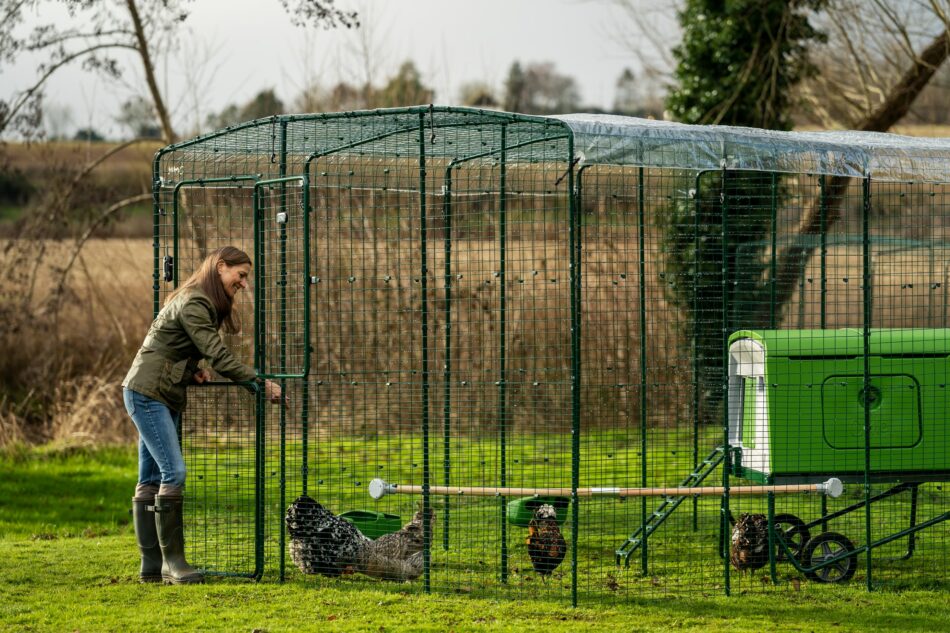
This entry was posted in Chickens on August 12th, 2020 by linnearask
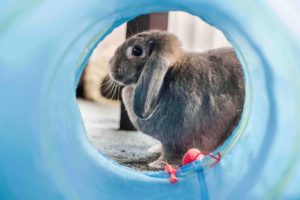
Rabbit owners often ask us if pet bunnies can swim. The answer is yes – but in many ways, it’s the wrong question. If you ask “Do rabbits enjoy swimming?”, the answer is definitely no.
Most mammals are capable of swimming, but not many actually take a dip unless they are forced to. We all know that cats hate water – but they can and will swim for safety if they have to. Rabbits are the same. In times of flood, or if chased by predators, they will sometimes jump in at the deep end and swim for it.
Which brings us to one of many rabbit myths. Bunnies have webbed feet – surely a sign of an animal intended for swimming? Well, no. The webbed feet are there to help rabbits hop and run – not swim.
What about all those swimming bunnies on YouTube?
A quick YouTube search will produce a list of video clips showing bunnies apparently enjoying themselves in garden pools; but you will struggle to find a clip in which the rabbit voluntarily enters the water. Some can be trained to do so, in the same way as a circus can train animals to do all sorts of things they wouldn’t otherwise choose to do. And that’s the main point – turning your pet rabbit into a circus act is inhumane.
In the various videos of swimming rabbits, the animals don’t appear panicked or distressed. But that’s just the rabbit’s way of surviving. It knows it can float, and it knows it can paddle to safety. It’s not going to thrash around and drown, and nor is it going to give any clues to how it’s feeling in its facial expressions. A rabbit serenely gliding across a garden pool is doing one thing only – surviving.
This has become a contentious issue, and there are even online petitions to prevent swimming bunny videos being posted online. As far as the signatories of the petitions are concerned, this is animal cruelty, nothing more and nothing less.
Healthy Swimming for Rabbits?
There is circumstantial evidence that some rabbits like to float in the water to ease arthritic problems, or simply to clean themselves and/or cool off. The only advice that can be given here – after taking such evidence with a pinch of salt – is to let the rabbit lead the way. A bunny who voluntarily takes a dip does not necessarily need dragging from the water and locking away somewhere dry and safe. The swimming is, no doubt, great exercise, just as it is for humans.
However, the fact that a rabbit enters the water may indicate an underlying problem – perhaps they do, indeed, have joint problems, or maybe their enclosure has an outbreak of fleas, lice or mites, something that might lead a bunny to desperate measures in the garden pool!
And the fact that it’s a garden pool presents another potential problem. Pools tend to have chlorine and other chemicals in the water, and these can irritate a rabbit’s eyes, nostrils and skin. Even untreated water can cause skin irritation if a rabbit remains wet for too long. Rabbits have very small lungs, too, and even a small amount of water breathed in by mistake can prove fatal.
If your pet rabbits voluntarily take to the water, dry them thoroughly after they’ve finished exercising. If you’re considering aquatherapy for rabbit joint-related problems, speak to a vet first.
The rule of thumb on this issue is simple – don’t put rabbits into pools or other bodies of water. Yes, they can swim; but no, they don’t like it. Usually!
This entry was posted in Rabbits on August 10th, 2020 by linnearask
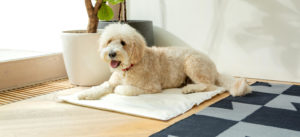
Just like humans’, dogs’ opinions on hot weather vary. Some absolutely worship the sun and will take any opportunity to find a sunny spot to lie down on, whereas others prefer to stay in the shade sipping some cold water, longing for autumn. Certain dogs are more likely to struggle with heat, including flat-faced breeds, dogs with thick coats, giant dogs, overweight dogs or dogs with underlying medical problems, so if your pooch is in a high risk group it’s extra important to make sure he or she stays cool. Here are some ways you can help you dog beat the heat:
1. Adjust Exercise
When it’s really hot outside it’s best to stay inside during the hottest hours of the day. Your dog will still need exercise, but if possible, stick to walks early in the morning or late at night when it’s cooler.
It’s also worth trying to walk as much in the shade as you can, to avoid hot pavements and tiles, and to stop your dog from running around too much whilst out on the walk, maybe by keeping them on a shorter lead.
2. Keep Hydrated
Make sure your dog always has access to clean, cold water, ideally in all rooms of the house. If you’re going out, bring a bottle of water and a foldable bowl.
If you’re worried your dog doesn’t drink enough water, try feeding them things that are hydrating and have a cooling effect. Frozen fruit and veg are great, but you can also put some cooked chicken in a blender with some banana or assorted berries and freeze in ice cube trays.
3. Get On Top of Grooming
This is extra important for breeds with thick fur, as they particularly struggle in the heat, but most dogs benefit hugely from some extra grooming in summer. For some, regular brushing to get rid of dead hair will be enough, but others need to have their coat properly trimmed for summer.
Don’t be tempted to grab the trimmers and give your dog a buzz cut; the sudden lack of insulation can shock the dog and damage the quality of the coat, as well as make him or her feel very self-conscious! Take them to the groomers and ask what they recommend for your dog’s type of fur.
4. Go For a Dip
Having water around to cool themselves down with will be highly appreciated by most dogs. You can put a shallow paddling pool in a shaded area of the garden, turn the sprinklers on and watch your dog run through them, or let him or her play with the garden hose.
If you live close to the sea or another body of water and your dog is used to swimming you can take them there to lower their body temperature in the evening. Remember that swimming can be tough exercise though, so call them back up when you’re happy they’ve cooled themselves down.
5. Keep Cool Inside
When it’s too hot to be outside, your dog will probably spend most of their time indoors, so it’s important to try and keep your house as cool as possible. It might be nice to open windows on different sides of the house to create drafts, or find other ways of letting cool air circulate. Drawing the curtains or blinds will help stop the sun from heating up bedrooms during the day.
6. Avoid The Car
If possible, try to avoid going in the car with your dog when it’s hot. We all know that you should never, ever leave a dog in a car in warm weather, it doesn’t matter if the car is parked in the shade, you’ve got the windows open and it’s only for a few minutes. A stationary car will quickly get very, very hot, and it can kill your dog.
If you can choose not to go in the car on very hot days, try to avoid it, especially if your dog is not a big fan to start with.
7. Get a Cooling Mat
On a hot day, your dog will love relaxing on something cooling. The Omlet Cooling Mat doesn’t require refrigeration or electricity, but works by absorbing heat from your dog’s body while at the same time cooling your pooch down. The memory foam mat is foldable and super comfortable, so you can take it with you wherever you go in summer, assuring your dog will always have a place to rest that will also minimise the risk of heatstroke.

This entry was posted in Dogs on August 6th, 2020 by linnearask
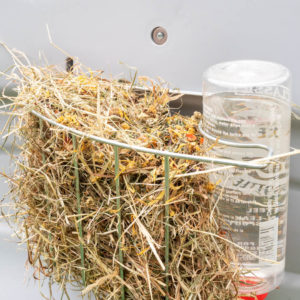
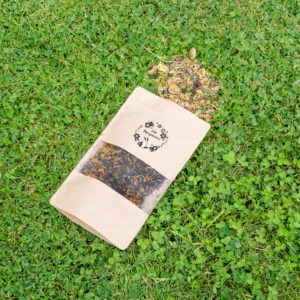
Omlet’s new herbal Pet-Pourri is the perfect way to treat your pet rabbits. The carefully selected blend of herbs and flowers will make the hutch smell lovely and fresh when mixed in with the bedding or hay.
Rabbits are known to nibble everything that comes in their way, so all ingredients are completely safe in moderate doses. In fact, they are all nutritious and flavoursome, and are thought to have medicinal properties that can support your rabbits’ skin, bones, immune system and respiratory and digestive organs.
Here is a list of the ingredients of Omlet’s Pet-Pourri, with a short introduction to why they might be beneficial to your rabbit!
There is no data to show to what degree these ingredients might be beneficial to rabbits, neither that they will be effective for all individuals. If you think your rabbit is not well, please contact your vet immediately to get help and advice.
Nettle – This green plant is one of the richest sources of chlorophyll around, and is high in iron, sodium and chlorine. Apart from repelling intestinal worms, it can also prevent many contagious diseases, and is said to be useful when your rabbit is battling eczema or arthritis.
Marigold Flower – Marigold can be good for wounds, bruises, ulcers and other skin problems. It also settles an upset rabbit tummy.
Hibiscus Flowers – Contains large amounts of antioxidants, and is a great source of vitamin C, something rabbits need on a daily basis. It has been shown to help prevent bladder infections as well as constipation.
Dandelion Leaf – This weed is quite the superfood for rabbits! It is said to help with respiratory ailments and bladder infections, is anti-inflammatory and can stop diarrhea. It is also recommended to give dandelion to a doe just after she’s had a litter, as it stimulates milk flow.
Chamomile Flower – Chamomile is a great treat for a nervous rabbit, as it is believed to have a calming effect, and can also work to help relieve pain. Made into an infusion with water it is great for washing weepy eyes.
Dried Carrot – Carrots are high in fibre, calcium and vitamin A, and will be a great treat for your pet.
Parsley – Apart from being flavoursome and crunchy, parsley enriches the blood and helps treat urinary problems. It has anti-inflammatory properties for the bladder and kidneys, and can help boost fertility.
Peppermint – Mint is said to be good for colds and eye infections, and can have a relaxing effect on the digestive tract, which is useful for problems with indigestion.
Basil – Some say this herb has cancer-preventing properties, and is believed to be good for problems with joints and muscles.
Fennel Seeds – Fennel is used to boost milk production for nursing does, and is thought to help calm a bloated stomach.
This entry was posted in Rabbits on August 5th, 2020 by linnearask


















